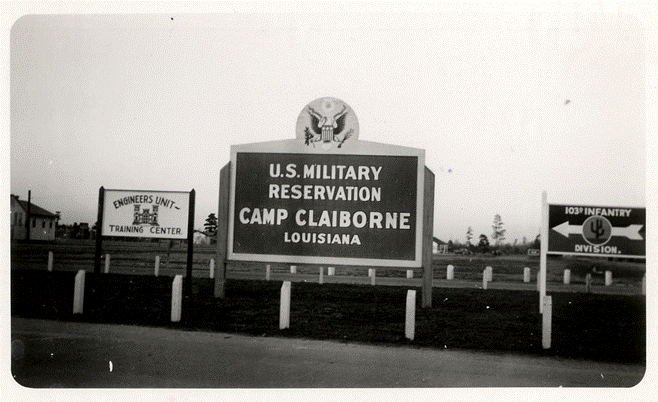


103d INFANTRY DIVISION WORLD WAR II ASSOCIATION

First Stop - Camp Claiborne, Louisiana
There was an old story about the first visit to town after grueling training at Camp Claiborne, Louisiana. It seems a group of solders were standing at a bus stop sign when a grizzled old sergeant came by, stopped, looked at the men for a moment and then spoke.
"What y'all doin?" The sergeant said with a smile.
"Waiting on the bus to town!" Replied several soldiers in unison.
"Ain't no bus." Said the sergeant.
"What's the bus stop sign for then?" A young, bright looking soldier asked.
"That's to kick when y'all find there ain't no town either."
Well, one thing for certain, once you arrived at Camp Claiborne it was going to be some time before you could even think about rest and recreation, and a visit to Alexandria and the great Bentley hotel bar.
In the Beginning, Camp Claiborne's sole reason for existence was to train soldiers for World War II. In all, in the six years it existed as a training center, over half a million men got their first taste of military operations in Rapides Parish located in central Louisiana. Camp Claiborne served as a German prisoner-of-war camp during the latter part of the war and was turned over to the National Forest Service in 1945 and was integrated into Kisatchie National Forest.
As in most times of peace, little thought is given to war and the hell a soldier must endure in combat. Nothing had changed in the years leading up to the attack on Pearl Harbor. It it was too hot, too cold, too wet, too dusty, or just too inconvenient training was suspended. After all, there was no pressing need to forced training on soldiers in these conditions. Little did the soldiers know how bad conditions would get when they deployed into the European Theatre of Operations. General Marshall, Chief of Staff of the Army knew. When faced with rising criticisms about his views on training, General Marshall responded:
"The business of the soldier, as I have found, involved mud, or extreme heat and irritating dust. It involves missing meals, long marches, bad weather, insects, and discomforts. It involves a great many inconveniences; it interferes with social and sometimes it very seriously affects personal relationships. All of this is inevitable and is part of the life of the soldier."
The men of Cactus division found that little quarter was given in the training they faced at Camp Claiborne. One thing for certain though, this training would later pay off and in a big way. During their time at Camp Claiborne, the infantry trained for the squad in the attack, the squad in the defense, squad in pursuit, and patrolling. When it was done, they did it again and again, and again. Gun crews fired their howitzers and learned the fine art of fire planning and execution. Communication guys faced problem after problem with wire and radio communications. They trained hard as it was a known fact that the backbone of any operation was the ability to communicate. Medics went over their aid station procedures, how to do triage, evacuation, and the grim task of identification. All this led to unit integrity and contributed to the strength the Cactus men would need during the grueling battles they would face in Europe.
Just when they thought they were about done, the entire training process faced a massive test during the Louisiana Maneuvers. Not the biggest one ever held at Camp Claiborne, but big enough to give these men the confidence they would need to go into battle. And was it ever hot during that summer. Rumors were running rampant that this was the hottest summer ever for central Louisiana.
The final event consisted of a successful attack against the Sabine River and crossing of that stream via Engineer bridges.
It was now November 15, 1943 and the basic and advanced Infantry Division training at Camp Claiborne was done. Time now to move on. Where? Camp Howze, Texas.
Visit the Camp Claiborne website at http://www.campclaiborne.com

Dale Center for the Study of War & Society • School of Humanities-History• College of Arts & Sciences
The University of Southern Mississippi • 118 College Drive #5047 • Hattiesburg, MS • 39406
webmaster Dr. Kenneth Swope
